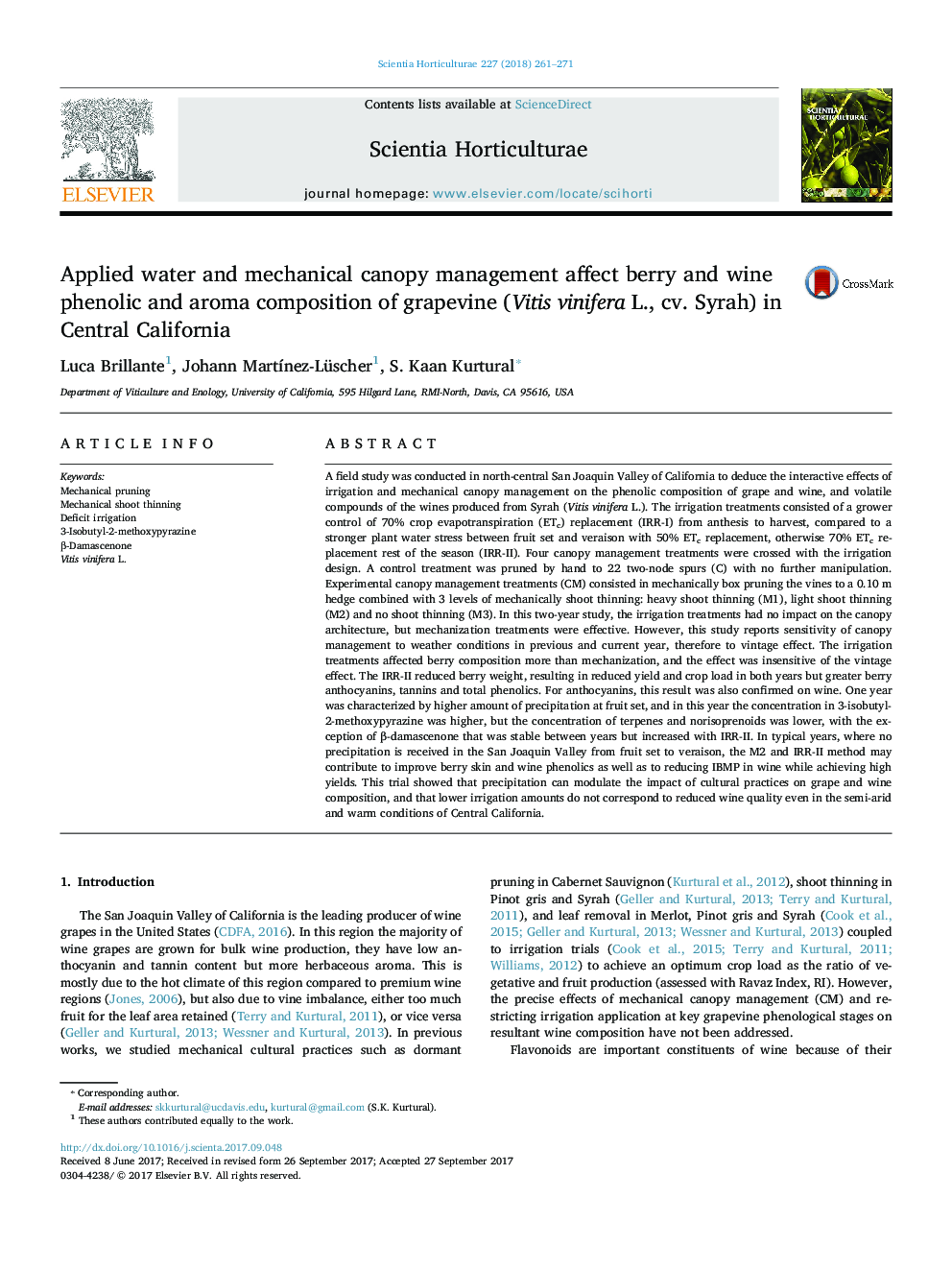| کد مقاله | کد نشریه | سال انتشار | مقاله انگلیسی | نسخه تمام متن |
|---|---|---|---|---|
| 5769479 | 1628771 | 2018 | 11 صفحه PDF | دانلود رایگان |

- Irrigation treatments had no impact on canopy architecture, but mechanical canopy management treatments were effective in controlling it.
- Stronger plant water stress between fruit set and veraison reduced yield, with greater anthocyanin, tannin and total phenolics in berry; the results were confirmed in wine with greater β-damascenone.
- Higher amount of precipitation at fruit set increased concentration of 3-isobutyl-2-methoxypyrazine, but the concentration of terpenes and norisoprenoids was lower.
- In typical years, where no precipitation is received in the SJV of California during the season, light mechanical shoot thinning and water stress between fruit set and veraison contributed to improved berry and wine phenolics as well as reducing IBMP in wine.
A field study was conducted in north-central San Joaquin Valley of California to deduce the interactive effects of irrigation and mechanical canopy management on the phenolic composition of grape and wine, and volatile compounds of the wines produced from Syrah (Vitis vinifera L.). The irrigation treatments consisted of a grower control of 70% crop evapotranspiration (ETc) replacement (IRR-I) from anthesis to harvest, compared to a stronger plant water stress between fruit set and veraison with 50% ETc replacement, otherwise 70% ETc replacement rest of the season (IRR-II). Four canopy management treatments were crossed with the irrigation design. A control treatment was pruned by hand to 22 two-node spurs (C) with no further manipulation. Experimental canopy management treatments (CM) consisted in mechanically box pruning the vines to a 0.10 m hedge combined with 3 levels of mechanically shoot thinning: heavy shoot thinning (M1), light shoot thinning (M2) and no shoot thinning (M3). In this two-year study, the irrigation treatments had no impact on the canopy architecture, but mechanization treatments were effective. However, this study reports sensitivity of canopy management to weather conditions in previous and current year, therefore to vintage effect. The irrigation treatments affected berry composition more than mechanization, and the effect was insensitive of the vintage effect. The IRR-II reduced berry weight, resulting in reduced yield and crop load in both years but greater berry anthocyanins, tannins and total phenolics. For anthocyanins, this result was also confirmed on wine. One year was characterized by higher amount of precipitation at fruit set, and in this year the concentration in 3-isobutyl-2-methoxypyrazine was higher, but the concentration of terpenes and norisoprenoids was lower, with the exception of β-damascenone that was stable between years but increased with IRR-II. In typical years, where no precipitation is received in the San Joaquin Valley from fruit set to veraison, the M2 and IRR-II method may contribute to improve berry skin and wine phenolics as well as to reducing IBMP in wine while achieving high yields. This trial showed that precipitation can modulate the impact of cultural practices on grape and wine composition, and that lower irrigation amounts do not correspond to reduced wine quality even in the semi-arid and warm conditions of Central California.
Journal: Scientia Horticulturae - Volume 227, 3 January 2018, Pages 261-271